In a dramatic turnaround, Intel has posted a significant profit in its latest quarterly report, marking the company’s first such result since the U.S. government stepped in as a major shareholder. Once a titan of the American technology industry, Intel reported a net income of $4.1 billion, or 90 cents per share, for the three months ending in September 2025. This figure stands in stark contrast to the $17 billion loss, or $3.88 per share, reported during the same period a year earlier, according to The Associated Press.
Intel’s revenue also saw a modest but notable boost, climbing 3% from the previous year to reach $13.7 billion. Investors responded enthusiastically to the news, with Intel’s stock rising nearly 8% in after-hours trading to $41.10—a surge that adds to the company’s recent upward momentum since the U.S. government’s investment this past summer.
The company’s financial revival comes at a pivotal moment. In August, President Donald Trump announced that the U.S. government would take a 10% stake in Intel. The move, aimed at strengthening companies considered vital to national security, was met with surprise across the political spectrum. For a Republican leader, it was a bold departure from long-standing party beliefs that governments should not intervene to pick corporate winners and losers using taxpayer money. Intel handed over the shares in exchange for nearly $9 billion that had already been granted under the CHIPS and Science Act of 2022, as reported by Economic Times.
The CHIPS and Science Act was designed to revitalize domestic semiconductor manufacturing and reduce reliance on foreign suppliers. In return for the government’s investment, Intel agreed to make major investments in U.S. manufacturing facilities—a move that aligns with broader efforts to secure America’s technological infrastructure in an increasingly competitive global landscape.
Intel’s recent financial windfall isn’t solely due to government intervention. The company also received $5 billion from rival chipmaker Nvidia in September and an earlier $2 billion infusion from Japanese technology giant SoftBank. These investments have provided much-needed capital as Intel attempts to regain its competitive edge in a market that has shifted dramatically over the past two decades.
At the helm of Intel’s transformation is CEO Lip-Bu Tan, who was recently installed to steer the company through turbulent waters. Tan has wasted no time in implementing sweeping changes, slashing thousands of jobs and mothballing projects that no longer align with Intel’s core strategy. These tough decisions are part of a broader effort to shore up the company’s finances and better position it against both domestic and foreign rivals that have, in many ways, overtaken the once-dominant chipmaker.
Founded in 1968 at the dawn of the personal computer revolution, Intel’s legacy is undeniable. For decades, the company’s chips powered the world’s computers, and its logo became synonymous with the digital age. Yet, as the technology landscape evolved, Intel struggled to adapt. The company famously missed the seismic shift to mobile computing triggered by Apple’s release of the iPhone in 2007. As smartphones and tablets became ubiquitous, Intel’s chips were largely absent from these devices—an oversight that cost the company dearly in market share and influence.
The challenges didn’t stop there. In recent years, the rise of artificial intelligence has further magnified Intel’s troubles. According to The Associated Press, Nvidia’s chips have become the hottest commodity in the booming AI sector, leaving Intel scrambling to catch up. While Intel remains a formidable player in the semiconductor industry, it now faces fierce competition from both established rivals and nimble newcomers alike.
Despite these headwinds, Intel’s recent results offer a glimmer of hope. The company’s return to profitability, though modest compared to its heyday, suggests that the restructuring efforts under Lip-Bu Tan are beginning to bear fruit. The decision to cut thousands of positions and shelve non-essential projects has helped reduce costs and refocus resources on areas with the greatest potential for growth.
Still, the road ahead is anything but certain. The decision by the U.S. government to take a 10% stake in Intel has sparked debate across the political spectrum. Supporters argue that bolstering domestic chip manufacturing is essential for national security and economic resilience, especially given recent disruptions in global supply chains. Critics, however, warn that such interventions risk distorting markets and could set a precedent for further government involvement in the private sector.
President Trump’s move has been described as "startling" by many observers, particularly given the Republican Party’s traditional opposition to government picking corporate winners and losers. Yet, the urgency of maintaining technological leadership in an era of geopolitical competition has prompted a rethinking of old orthodoxies. As the Economic Times noted, Intel’s agreement to invest heavily in U.S. manufacturing facilities was a key condition for receiving the nearly $9 billion in government funds.
In addition to government support, Intel’s partnerships with Nvidia and SoftBank signal a willingness to collaborate—even with rivals—if it means securing the company’s future. The $5 billion investment from Nvidia is particularly notable, given the fierce competition between the two companies in the AI and high-performance computing markets. Meanwhile, SoftBank’s $2 billion contribution earlier in 2025 underscores the global nature of the semiconductor industry and the importance of cross-border alliances.
Looking back, Intel’s journey reads like a cautionary tale for tech giants everywhere: adapt or risk irrelevance. The company’s failure to capitalize on the mobile revolution and its initial missteps in the AI era have forced it to reinvent itself under challenging circumstances. Yet, as the latest results show, reinvention is possible—even for a company of Intel’s size and stature.
For now, investors are cautiously optimistic. The nearly 8% jump in Intel’s stock price following the earnings announcement reflects renewed confidence in the company’s prospects. However, much will depend on Intel’s ability to execute its turnaround strategy, deliver on its promises to invest in U.S. manufacturing, and carve out a meaningful role in the fast-evolving world of artificial intelligence.
As the dust settles, Intel’s comeback story remains a work in progress—a testament to resilience, adaptation, and the sometimes surprising ways in which public and private interests can intersect in the high-stakes world of technology.


